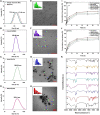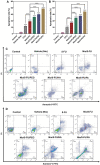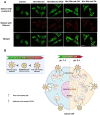Folic Acid-Decorated pH-Responsive Nanoniosomes With Enhanced Endocytosis for Breast Cancer Therapy: In Vitro Studies
- PMID: 35517801
- PMCID: PMC9065559
- DOI: 10.3389/fphar.2022.851242
Folic Acid-Decorated pH-Responsive Nanoniosomes With Enhanced Endocytosis for Breast Cancer Therapy: In Vitro Studies
Abstract
Breast cancer is the most common invasive cancer in women and the second leading cause of cancer death in women after lung cancer. The purpose of this study is a targeted delivery toward in vitro (on MCF7 and 4T1 breast cancer cell lines) through niosomes-based nanocarriers. To this end, different bioactive molecules, including hyaluronic acid (HA), folic acid (FA), and polyethylene glycol (PEG), were used and compared for surface modification of niosomes to enhance endocytosis. FA-functionalized niosomes (Nio/5-FU/FA) were able to increase cell cytotoxicity and reduce cell migration and invasion compared to PEG-functionalized niosomes (Nio/5-FU/PEG), and HA-functionalized niosomes (Nio/5-FU/HA) groups in MCF-7 and 4T1 cell lines. Although the Nio/5-FU/PEG and Nio/5-FU/HA demonstrated MCF7 cell uptake, the Nio/5-FU/FA exhibited the most preponderant endocytosis in pH 5.4. Remarkably, in this study 5-FU loaded niosomes (nonionic surfactant-based vesicles) were decorated with various bioactive molecules (FA, PEG, or HA) to compare their ability for breast cancer therapy. The fabricated nanoformulations were readily taken up by breast cancer cells (in vitro) and demonstrated sustained drug release characteristics, inducing cell apoptosis. Overall, the comprehensive comparison between different bioactive molecules-decorated nanoniosomes exhibited promising results in finding the best nano formulated candidates for targeted delivery of drugs for breast cancer therapy.
Keywords: 5-FU; breast cancer; endocytosis; folic acid; hyaluronic acid; niosome.
Copyright © 2022 Rezaei, Rezaei, Karimifard, Mahmoudi Beram, Dakkali, Heydari, Afshari-Behbahanizadeh, Mostafavi, Bokov, Ansari, Farasati Far, Akbarzadeh and Chaiyasut.
Conflict of interest statement
The authors declare that the research was conducted in the absence of any commercial or financial relationships that could be construed as a potential conflict of interest.
Figures








Similar articles
-
Folate-Targeted Curcumin-Loaded Niosomes for Site-Specific Delivery in Breast Cancer Treatment: In Silico and In Vitro Study.Molecules. 2022 Jul 20;27(14):4634. doi: 10.3390/molecules27144634. Molecules. 2022. PMID: 35889513 Free PMC article.
-
pH-Responsive, Adorned Nanoniosomes for Codelivery of Cisplatin and Epirubicin: Synergistic Treatment of Breast Cancer.ACS Appl Bio Mater. 2022 Feb 21;5(2):675-690. doi: 10.1021/acsabm.1c01107. Epub 2022 Feb 7. ACS Appl Bio Mater. 2022. PMID: 35129960 Free PMC article.
-
Fabrication, optimization, and characterization of pH-responsive PEGylated nanoniosomes containing gingerol for enhanced treatment of breast cancer.Naunyn Schmiedebergs Arch Pharmacol. 2023 Dec;396(12):3867-3886. doi: 10.1007/s00210-023-02579-2. Epub 2023 Jun 27. Naunyn Schmiedebergs Arch Pharmacol. 2023. PMID: 37368028
-
Preparation, Optimization and In vitro Evaluation of Doxorubicin-loaded into Hyaluronic Acid Coated Niosomes Against Breast Cancer.Chem Biodivers. 2024 Feb;21(2):e202301470. doi: 10.1002/cbdv.202301470. Epub 2024 Jan 18. Chem Biodivers. 2024. PMID: 38161147
-
Engineered hyaluronic acid-decorated niosomal nanoparticles for controlled and targeted delivery of epirubicin to treat breast cancer.Mater Today Bio. 2022 Jul 6;16:100349. doi: 10.1016/j.mtbio.2022.100349. eCollection 2022 Dec. Mater Today Bio. 2022. PMID: 35875198 Free PMC article.
Cited by
-
Potential of Natural Phenolic Compounds against Doxorubicin-Induced Chemobrain: Biological and Molecular Mechanisms Involved.Antioxidants (Basel). 2024 Apr 18;13(4):486. doi: 10.3390/antiox13040486. Antioxidants (Basel). 2024. PMID: 38671933 Free PMC article. Review.
-
Fabrication of Chrysin-Loaded Hyaluronic Acid Decorated Niosomal Nanoparticles: Potential Anti-inflammatory and Anti-osteoclastic Effects on PBMCs of Rheumatoid Arthritis Patients.Adv Pharm Bull. 2025 Jan 5;15(1):95-106. doi: 10.34172/apb.43185. eCollection 2025 Apr. Adv Pharm Bull. 2025. PMID: 40636298 Free PMC article.
-
Multi-responsive chitosan-based hydrogels for controlled release of vincristine.Commun Chem. 2023 Feb 10;6(1):28. doi: 10.1038/s42004-023-00829-1. Commun Chem. 2023. PMID: 36765265 Free PMC article.
-
Functionalization of curcumin nanomedicines: a recent promising adaptation to maximize pharmacokinetic profile, specific cell internalization and anticancer efficacy against breast cancer.J Nanobiotechnology. 2023 Mar 25;21(1):106. doi: 10.1186/s12951-023-01854-x. J Nanobiotechnology. 2023. PMID: 36964547 Free PMC article. Review.
-
Targeted delivery of oxaliplatin via folate-decorated niosomal nanoparticles potentiates resistance reversion of colon cancer cells.Heliyon. 2023 Oct 29;9(11):e21400. doi: 10.1016/j.heliyon.2023.e21400. eCollection 2023 Nov. Heliyon. 2023. PMID: 37954331 Free PMC article.
References
-
- Akbari J., Saeedi M., Enayatifard R., Morteza-Semnani K., Hassan Hashemi S. M., Babaei A., et al. (2020). Curcumin Niosomes (Curcusomes) as an Alternative to Conventional Vehicles: A Potential for Efficient Dermal Delivery. J. Drug Deliv. Sci. Tech. 60, 102035. 10.1016/j.jddst.2020.102035 - DOI
-
- Akbarzadeh I., Tavakkoli Yaraki M., Ahmadi S., Chiani M., Nourouzian D. (2020a). Folic Acid-Functionalized Niosomal Nanoparticles for Selective Dual-Drug Delivery into Breast Cancer Cells: An In-Vitro Investigation. Adv. Powder Tech. 31 (9), 4064–4071. 10.1016/j.apt.2020.08.011 - DOI
-
- Akbarzadeh I., Tavakkoli Yaraki M., Bourbour M., Noorbazargan H., Lajevardi A., Sadat Shilsar S. M., et al. (2020b). Optimized Doxycycline-Loaded Niosomal Formulation for Treatment of Infection-Associated Prostate Cancer: An In-Vitro Investigation. J. Drug Deliv. Sci. Tech. 57, 101715. 10.1016/j.jddst.2020.101715 - DOI
-
- Alemi A., Zavar Reza J., Haghiralsadat F., Zarei Jaliani H., Haghi Karamallah M., Hosseini S. A., et al. (2018). Paclitaxel and Curcumin Coadministration in Novel Cationic PEGylated Niosomal Formulations Exhibit Enhanced Synergistic Antitumor Efficacy. J. Nanobiotechnology 16 (1), 28–20. 10.1186/s12951-018-0351-4 - DOI - PMC - PubMed
LinkOut - more resources
Full Text Sources

